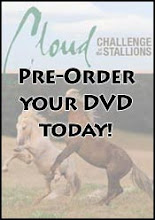A Comparative Analysis of Wild Free-Roaming Horses & Burros
In Relation to Habitat, Wildlife and Livestock Populations”
by C.R. MacDonald, October, 2009
Recently, Secretary of the Interior Ken Salazar Sez’s, “There’s just no room for wild horses and burros out West anymore”.
With the drought taking its toll on Western rangelands, wildlife struggling to survive, and out of control reproduction rates and populations of wild horses and burros constantly threatening fragile arid habitats, Salazar Sez’s, "The time has come to sterilize most of what is left, both on and off the range, and ship America’s Mustangs & Burros to private sanctuaries far removed from their native ranges on public lands".
Salazar Sez’s, “Let us not look behind the scenes at how we got here but only look ahead at this new solution for the Wild Horse & Burro Program”, a solution many are already coining the final one.
Never mind the fact that for two decades, the Government Accountability Office has repeatedly issued reports stating the obvious; BLM cannot provide evidence that removing wild horses and burros improves rangeland health and that the entire concept of excess is based on “informal decisions made by BLM Field Managers” – no data required.
Salazar Sez’s, “Who needs BLM to finally publish their long-awaited acreage report before they hustle more wild horses and burros off the range to multi-million dollar private sanctuaries instead?”
And, “Why bother publishing the new policy manual BLM has been writing (for 40 years now!) to establish guidelines on how BLM should go about determining what is appropriate use for wild horses and burros?” After all, BLM would just ignore it anyway like so much else - so why create a legal precedent before shipping most of them to privately owned sanctuaries?
Salazar Sez’s, “Who needs a Congressional investigation into what the Department of the Interior has done to get us to this point?” Despite the DOI’s abysmal reputation for ethic violations, never mind that now, Salazar’s here and those days are behind us!
Salazar Sez’s, “We don’t need an independent count of what’s in the holding pens” – despite the fact that nobody has ever seen all these “excess” horses causing such financial distress. And Salazar doesn’t seem too interested in looking into an independent census of what’s still remaining on the range because, as Salazar Sez’s, “We are going to create a new home for them now anyway!”
Despite nearly a decade of mass cleansings, which has swept the majority of our herds from their ranges, Salazar Sez’s, “Danger! Danger! Excessive wild horses and burros must go now!” and as a result, BLM has scheduled the removals of over 12,000 more wild horses and burros this year based solely on those ‘informal manager decisions’ – even though Salazar’s own home state of Colorado has reported their 292,000 elk have been “over population objectives for the last 20 years” (1) – what’s a decade or two when it comes to elk.
Before following what Salazar Sez’s – because this is not a game and we are not children anymore - let’s take a serious look at what “excess” wild horses and burros on public lands means to Secretary Salazar and BLM before we blindly follow the newest Judas horse just released before the public.
Click on the link above, "The Thriving Natuaral Ecological Balance", to review the full collection of State by State analysis of wild horses and burros populations compared to “everything else”, forage allocations of livestock, and available habitat on federally managed lands.
(1) Taken from "Elk Management in 5 Western States: (Montana, Wyoming, Idaho, Colorado, and Utah)".






























